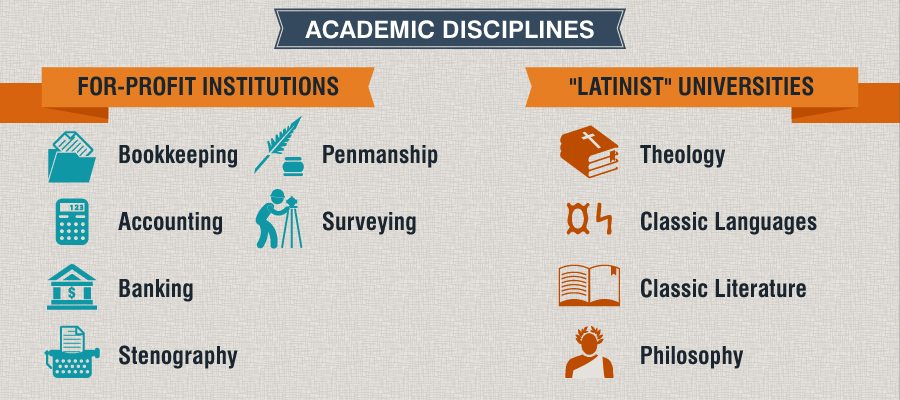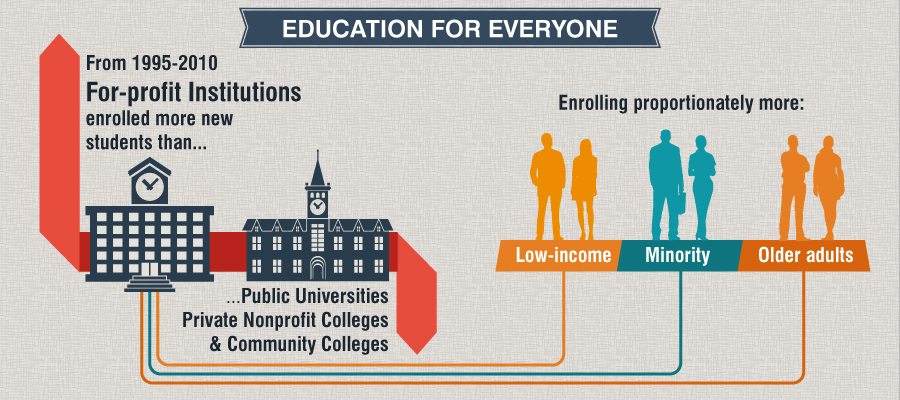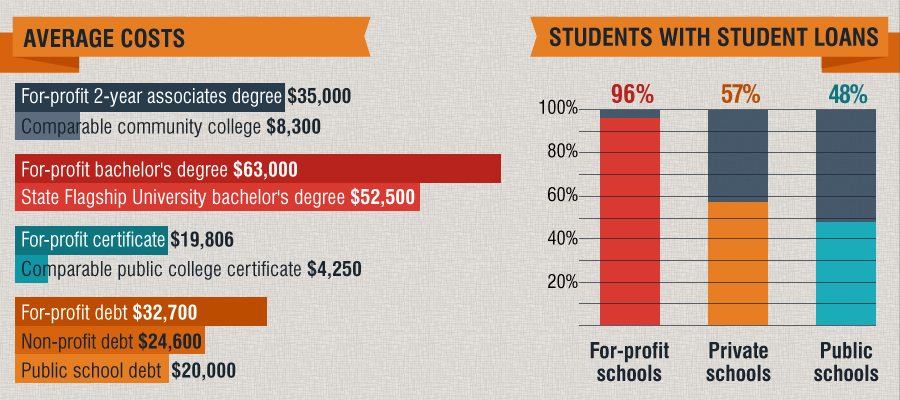Education has always been taught for a profit, from tutors in the ancient world, to clergymen offering training in subjects not covered in early American Universities. Early for-profit institutions often taught practical skills that couldn’t be obtained easily from traditional Universities, and often filled a price gap, allowing the working classes to obtain education. Benjamin Franklin was a proponent of these early for-profit schools. As a largely self-taught and apprenticeship-learned individual, he was a success story for those who didn’t think traditional education was necessary. Throughout his life he fought against “Latinists” whose ideas centered around the British models of Cambridge and Oxford. A model centered around theology, Greek and Latin, classic literature, and philosophy. Traditionally those who wanted training in commerce or the modern sciences were out of luck with University offerings. As noted by Richard Ruch, author of Higher Ed, Inc.:The Rise of the For-Profit University Harvard’s library was composed of almost 60% theology books in 1723, with only two books about commerce. A fertile ground for the establishment of smaller trade schools, and schools centered around skills students were seeking to learn.
Early For-Profit Institutions
In 1897, 123,913 students were in commercial courses in high school and college. 60% of these students were in college, with more than 92% of the collegiate group enrolled in new for-profit commercial colleges. It was obvious that the new urbanized and industrialized America had need of a new skill set, but the success of new for-profit schools in providing for this need varied widely. There were, of course, success stories, including Andrew Carnegie, who attended a commercial college at night to learn bookkeeping, and John D. Rockefeller, who studied accounting, penmanship, and banking at a commercial college in Cleveland. But standards weren’t enforced. Some schools were shut down locally, and others were increasingly sanctioned by government organizations. But the growth of for-profit did signal one thing, traditional colleges weren’t providing for the entire population. Many advocates pointed to vocational school models similar to Germany’s vocation and apprentice-centered tracks, though for-profit schools were much more likely to cater to working adults.

Around WWI, having a well trained domestic work force was starting to be viewed not only as an economic boon, but as a matter of national security. The Smith-Hughes Act in 1917 provided federal funding for those seeking vocational training for agricultural work. A byproduct of the bill is that it included stipulations segregating funding for agriculture-related vocational training from funding for traditional academic subjects, effectively widening the gap between types of higher education. The George Barden act expanded this federal funding to subjects such as trade, home economics, and industry around 1947, then the National Defense Education of the following year increased funding for science, math, and foreign languages (as they weren’t prominent in the classic model of education). Through the 60’s added infrastructure and federal funding was made available for vocational schools, and the connection between vocational and practical STEM topics was increased even more.
As the push for “vocational” training in the name of national defense continued, many of today’s largest for profit colleges were formed, taking advantage of the convergence of vocational education funding, and more and more potential students looking for skill-based educations. Though several for-profit schools have survived since their trade school days in the 19th century, schools like University of Phoenix (founded in 1976) really brought modern for-profit education to the attention of most Americans. From the 1970’s to today, the percentage of degree-seeking students at for-profit institutions has increased from .2% to 12% of students today. A number of other prominent for-profit institutions were founded around the time of University of Phoenix, including ITT Technical Institute (1969) and Walden University (1970).
Education Becomes Big Business
Historically, for-profit institutions performed a vital role in education, offering vocational qualifications, and part-time programs primarily for working adults. However, these institutions were often small, and locally based. So what was it that propelled for-profit institutions into massive international organizations? The growth of online education has allowed many decentralized campuses to spread and reach more–particularly working, adult–students. The rising need for skill-based education in the workforce–the growing number of Americans with money to spare for education–and the fact that for-profit education has come across several proven business models are other key elements in the expansion of for-profit institutions.
John Sperling’s life, from being born into a working class family, to getting his doctorate at Cambridge University, to founding the University of Phoenix, sheds some light on the allure and prosperity of for-profit colleges. Ten years into the great depression, Sperling was a merchant marine, whose first thought of going to school came from being exposed to other marines who were socialist, and igniting a sort of intellectual curiosity in him. After starting as a community college student who attended class in the day, and worked as a gas station attendant at night, Sperling was able to transfer to the prestigious liberal arts school, Reed. He majored in history, excelled, and continued his education at UC Berkeley and later Cambridge.
These fine institutions were great for Sperlings future career, but they also exposed a disconnect between Sperling and his classmates, many of whom were much more privileged, and took for granted scholastic successes that Sperling, as a working student had found more difficult due to economic circumstance. While Sperling continued on to become a professor at San Jose State, he took with him a passion for union organizing, as well as a desire to extend education in a format for working adults. In the late 60’s, fed up with the privilege, and unchanging higher education landscape, Sperling saw his opportunity through a Federal grant designed to lower juvenile delinquency rates among working-class kids in the neighboring town of Sunnyvale. Sperling thought the best way to reach delinquent students was to touch those who were in contact with them. So he enrolled 30 teachers and police officers in a class and divided them by level. He realized they all aspired to learn more, and that there was a need for working adult education. Police officers who had associates degrees wanted their bachelor’s, and teachers who had their bachelor’s wanted their masters. Fast forward to 1989 and the University of Phoenix was receiving 200,000 information requests a week regarding their innovative online MBA. By 1994, the University of Phoenix (under the umbrella corporation called the Apollo Group), was becoming a publicly traded company and a model for institutions formed at even later dates, like the world’s largest for-profit institution Laureate Education Inc.

Since 1995, one third of all new students enrolling in higher education have been students at for-profit institutions. Meaning that by 2010, yearly enrollments in for-profit institutions had risen to 1.7 million students. For perspective, note that total enrollment in degree-granting post secondary institutions was 17.8 million in 2012. Private 4-year for-profit universities are the most noticeably prominent when looking at undergraduate, degree-seeking students who participate exclusively in distance courses, where private 4-year, for-profit institutes account for a massive 58% of students. But even with the massive growth in for-profit education, modern for-profit education has more than its fair share of detractors.
[Tweet “Private 4-year, for-profit institutes account for a massive 58% of students”]
Bad Reviews
The numbers don’t lie, and though there are millions of success stories coming out of for-profit institutions, many have cited lacking outcomes (when compared to non-profit schools) as evidence that for-profit institutions need to more highly regulated. President Obama is the latest high profile politician to come out against for-profit career training institutions. While his proposed legislation would also affect some public and non-profit institutions, by targeting schools with the worst student debt to future earnings ratios, many for-profit schools would be targeted as well. Besides what some believe to be predatory practices of giving potential students inaccurate information about outcomes then leaving them with debt, the issue becomes a national fiscal issue due to the tens of billions in federal student aid that subsidize such programs.

On the other hand, Bill Clinton is currently the spokesman of Laureate Education Inc, the world’s largest for-profit university system. Laureate currently earns in excess of $4 billion yearly, and says that they are expanding access to education like never before. With increasing regulations in America, Laureate actually makes most of their profits in Latin America. In countries with much lower post-secondary education rates than America, companies like Laureate really are expanding access to education in leaps and bounds. International expansion is a new development, so it is yet to be seen whether or not for-profit institutions can deliver on their promises to students abroad, or whether this is just putting those who can afford to take out student loans even less at greater risk.
[Tweet “With increasing regulations in America, Laureate actually makes most of their profits in Latin America”]
It should be noted that we’re speaking in averages here, and program quality can vary widely from institution to institution. As it stands, the costs of for-profit bachelor’s degrees are about 20% higher than degrees at state flagship universities. And debt for 4-year degrees from for-profit institutions still falls below the range of high debt level public schools ($32,700 and $33,650-$41,650, respectively). This leaves the alleged problem with for-profit institutions centered on lack of quality instruction and the inability to churn out graduates who are prepared to pay back even a moderate level of student debt. While both for-profit and non-profit universities are both party to bad instruction at times, this seems more a matter of accreditation, as well as allowing for online teaching techniques to mature and reach their potential. For-profit education can be both good and bad, often providing greater flexibility for working adults, but often costing more than non-profit institutions. If you’re leery about a for-profit educational opportunity, just remember, it’s education for the bottom line, and with tens of thousands of students, they don’t have to worry about making you happy.
Citations:
- http://www.huffingtonpost.com/2012/08/09/for-profit-higher-educati_n_1761369.html
- http://americanradioworks.publicradio.org/features/tomorrows-college/phoenix/story-of-university-of-phoenix.html
- http://www.rockinst.org/observations/kinserk/2011-08-for-profit_higher-ed.aspx
- http://www.businessinsider.com/laureate-education-global-growth-2014-1